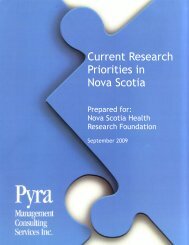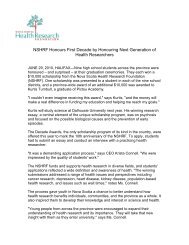Major Health Issues in Nova Scotia: An Environmental Scan
Major Health Issues in Nova Scotia: An Environmental Scan
Major Health Issues in Nova Scotia: An Environmental Scan
Create successful ePaper yourself
Turn your PDF publications into a flip-book with our unique Google optimized e-Paper software.
<strong>Health</strong> Status<br />
Over 5000 <strong>Nova</strong> <strong>Scotia</strong>ns die of four types of chronic diseases every year: cancer,<br />
cardiovascular diseases, chronic respiratory diseases and diabetes. Sixty four<br />
percent of all deaths <strong>in</strong> <strong>Nova</strong> <strong>Scotia</strong> are attributable to these diseases. 3<br />
For self reported conditions, the percentage of <strong>Nova</strong> <strong>Scotia</strong>ns report<strong>in</strong>g the<br />
follow<strong>in</strong>g is higher than the national average:<br />
current daily smokers age 12 and over (NS: 24.4%, Canada: 21.9%) ;<br />
heavy dr<strong>in</strong>kers (5 or more dr<strong>in</strong>ks on one occasion 12 or more times per<br />
year) (NS: 28.6%, Canada: 21.8%);<br />
body mass <strong>in</strong>dex of 30 or higher (NS: 20.1%, Canada: 16.0%); and<br />
high blood pressure ((NS: 19.0%, Canada: 15.9%). 7<br />
Fewer <strong>Nova</strong> <strong>Scotia</strong>ns than the national average consume 5 or more fruits and<br />
vegetables per day (NS: 33.0%, Canada 41.3%). <strong>Nova</strong> <strong>Scotia</strong>ns report the third<br />
highest percentage of diabetes (NS: 6.8%, Canada: 5.8%) and the highest<br />
percentages of arthritis or rheumatism (NS: 23.0%, Canada: 15.0%) and asthma<br />
(NS: 10.8%, Canada:8.0%). 7<br />
<strong>Health</strong> Disparities<br />
A study of socioeconomic <strong>in</strong>equality <strong>in</strong> health <strong>in</strong> Atlantic Canada confirmed that<br />
health disparities exist <strong>in</strong> Atlantic Canada. The study concluded that the<br />
contribution of all the other health determ<strong>in</strong>ants to socioeconomic <strong>in</strong>equality can<br />
be traced back to differences <strong>in</strong> <strong>in</strong>come between <strong>in</strong>dividuals, and that health<br />
disparities can be reduced with a focus on efforts to improve the <strong>in</strong>comes of low<strong>in</strong>come<br />
people. 19 Other evidence that some <strong>Nova</strong> <strong>Scotia</strong>ns experience health<br />
disparities is available. For example, when compared to the rest of Canada, <strong>Nova</strong><br />
<strong>Scotia</strong> has the highest percentage of households experienc<strong>in</strong>g food <strong>in</strong>security<br />
(14.6%). 20<br />
In a report on the health costs of poverty, Hayward and colleagues exam<strong>in</strong>ed the<br />
l<strong>in</strong>kages between poverty and exposure to health risk conditions and lack of social<br />
support. 18 The strong l<strong>in</strong>ks between <strong>in</strong>come and health status and risk factors for<br />
disease, and the existence of health disparities <strong>in</strong> <strong>Nova</strong> <strong>Scotia</strong> suggest that health<br />
disparities are a significant health issue for <strong>Nova</strong> <strong>Scotia</strong>.<br />
<strong>Health</strong> System <strong>Issues</strong><br />
The Prov<strong>in</strong>cial <strong>Health</strong> Services Operational Review (PHSOR) report released <strong>in</strong><br />
January 2008 provided a comprehensive overview of <strong>Nova</strong> <strong>Scotia</strong>’s health system<br />
and offered many recommendations for transform<strong>in</strong>g the system. At a high-level,<br />
the report recommends focuss<strong>in</strong>g health care services <strong>in</strong> the community beg<strong>in</strong>n<strong>in</strong>g











